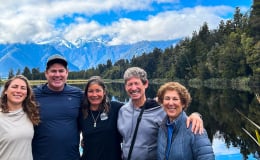
The Most Beautiful Lakes In The South Island
New Zealand's South Island is a land of immense natural beauty. From the towering snow-capped peaks of the Southern Alps to the golden sand beaches of the Abel Tasman, the diverse landscape is filled with picture-perfect views at every turn. If our remarkable mountain ranges are New Zealand's crown, then our spectacular lakes are surely the glittering jewels.
Here is a list of some of our favourites!
Lake Whakatipu
Several of our guided adventures start off in beautiful Queenstown, on the shores of New Zealand’s longest lake, Lake Whakatipu (Whakatipu Waimāori). The lake was carved out about 15,000 years ago during the last ice age and sits about 310m (1017ft) above sea level.
Interestingly, at its deepest point, it actually dips below sea level at 380m (1246ft). Whakatipu is the third largest lake in New Zealand, snaking its way through Kingston, Queenstown and Glenorchy, in an ‘S’-type formation.
In Māori legend, Lake Whakatipu is said to be formed by a sleeping taniwha (giant), Matau, with his head resting at Glenorchy, his knees at Queenstown and his feet in Kingston. As the story goes, the taniwha kidnapped a precious daughter of a local chief, and after being saved by her love, Matakauri, he decided he would put an end to the taniwha, and set him alight, forming a crater in the shape of his sleeping body. It’s said the only part of the taniwha that didn’t burn was his heart, which is known today as Pigeon Island.
One of the most mystical features of Lake Whakatipu is a phenomenon called a lake ‘seiche’, where the lake rises and falls by 20cm (8 inches) every 27 minutes. While the scientific explanation is that it’s caused by wind, mountains and atmospheric pressures, Māori legend explains this as the still beating heart of Matau the taniwha.
Don’t let that taniwha scare you off though! There are so many things to do in, on and around the lake.
You can kayak out to Matau’s beating heart, go walking or biking on the lakeside sections of the Queenstown Trail or head downtown to Steamer’s Wharf for some lakeside dining.
Downtown you’ll also find a host of activities including: Hydro Attack - a semi-submersible shark machine, jet boats, day cruises, and of course, the famed Earnslaw steamship, which travels out to scenic Walter’s Peak.

The TSS Earnslaw steaming across Lake Whakatipu
If you’re looking for something a little less high-octane, Frankton beach makes for an awesome windsurfing, swimming and paddle-boarding spot as do other bays along the lake including Bob’s Cove and Wilson’s Bay.
Almost all the bays have picnic tables and public toilets and St Omer’s Park, close to Steamer’s Wharf, has public barbeque facilities.
There are several scenic camping spots dotted around the lake between Kingston and Glenorchy including:
- Twelve Mile Delta (Queenstown)
- Moke Lake (Queenstown)
- Beach Point (Queenstown - only accessible by boat or mountain bike)
- Kinloch Campsite (Glenorchy)
- Kingston Lake Camp (Kingston)
Each ranges in pricing from $10NZD to $20NZD per person and has basic toilet facilities.
Our Masterpiece, Kiwi Classic, Great Walk Adventure, and The Grand Explorer trips start and finish in Queenstown. It’s a great idea to book yourself a few extra days on either end of your trip, so you have time to enjoy all of Lake Whakatipu’s wonders!
Wānaka
As the locals say, ‘just over the hill’ from stunning Lake Whakatipu is Lake Wānaka, New Zealand’s fifth largest lake.
Lake Wānaka is hugely popular for boating, swimming, sailing, parasailing and if you’re game, aqua biking!
Perhaps what it’s most famous for though is ‘That Wānaka Tree’ - which has been described as one of the most photographed places in New Zealand. It’s a lone willow tree, growing slightly offshore in the south end of the lake. More than 80 years ago, It was originally a fence post that a farmer fashioned from a branch of a willow tree which over time turned into the icon people travel to see today.
The lake itself spans 192km2 (74mi2), is estimated to be about 311m (1020ft) deep (it also dips below sea level) and is a close neighbour with Lake Hawea. Both fashioned by glacial movements, the two are separated by a pass called ‘the neck’. Both lakes are surrounded by hugely popular campsites - including The Camp (Hawea) and Glendhu Bay (Wānaka) plus a range of well-maintained Department of Conservation (DoC) campsites.

One of the best views of Lake Wānaka is from the Rocky Mountain trail.
Used as a base for many active adventures today, the first European settlers’ journeys into the area were not too dissimilar to those with a penchant for long hikes and water sports. Nathaniel Chalmers - the first European to arrive at Lake Wānaka - had walked with Māori chief, Reko, from Tuturau (at the bottom of the South Island) to Wānaka via the Kawarau Gorge (which runs through Queenstown), then returned by raft down the Clutha River.
Our Pure South, Masterpiece and Grand Explorer adventures each spend two days exploring Wānaka. You’ll get elevated views of the lake while hiking Rocky Mountain, you’ll dine at one of the many great lakefront restaurants and if you need to get gifts back home Wānaka is the perfect spot to pick up a souvenir… or ten!
Tasman Lake, Hooker Lake and Lake Pukaki
Aoraki/Mount Cook National Park is home to some of New Zealand’s most impressive and interactive examples of glacial lakes.
Two of our favourites are the Tasman and Hooker Lakes. Our guests are always stunned by the magical, milky blue-grey colour of the lakes, caused by extremely fine, suspended silt (rock flour) - not to mention views of the Tasman Glacier, the longest glacier in New Zealand at 22km (14mi).
Hooker Lake is an iceberg-filled treat at the end of a leisurely 5km (3mi) walk along the Hooker Valley floor, and one of the best viewing spots of the mighty Aoraki/Mount Cook. It’s actually quite a young lake, beginning to form in the 1970s due to the recent retreat of Hooker Glacier. Since then, the Glacier has averaged a retreat of about 50m (164ft) per year.
Tasman Lake is just a 10-minute drive out of Mount Cook Village, if you follow the Tasman Lake Track from the Blue Lakes Carpark, you’ll end up at a spectacular viewpoint.
A Glacier Explorer boat runs tours on the lake, which is your opportunity to get right up next to some amazing icebergs before you reach the terminal face of New Zealand’s longest glacier!

One of our groups heli-hiking on the Tasman Glacier.
Visiting these lakes and the surrounding hiking spots is truly a special experience. Mount Cook Village, your gateway to all these amazing land features, is kept super simple, so that it feels like it’s just you and all this amazing scenery. Light pollution is kept to a minimum, making it an incredible spot for stargazing on a clear night.
Hot tip, there is a restaurant and bar in the village at the Hermitage Hotel, but if you’re planning on cooking, snacking or sharing a bottle of wine, be sure to make a quick stop in a nearby town - like Twizel - and stock up!
As you drive out of Aoraki/Mount Cook, you’ll be farewelled by the glorious Lake Pukaki, when conditions are right, it’s the most brilliant shade of aqua blue you may ever see!

The stunning blue of Lake Pukaki, Aoraki/Mt Cook in the distance.
Lake Pukaki is part of a hydroelectric network and is about 178km2 (69mi2). The lake sits just over 500m (1640ft) above sea level, and interestingly, the lake level can be raised or lowered depending on hydroelectric needs.
You’ll see the Tekapo B power station on the lakeside which is where all the hydroelectric magic happens! Combined with Lake Tekapo, the two lakes’ hydroelectric storage capacity makes up about half of all of New Zealand’s total hydroelectricity storage capacity.
Part of the 300km (186mi) Alps to Ocean bike trail follows along the edge of Lake Pukaki for some truly scenic riding.
All of our South Island adventures head into Aoraki/Mount Cook National Park, check out which one is right for you here.
Lake Tekapo
Lake Tekapo, located about three hours south-west of Christchurch, is pretty as a postcard! In fact, you might have already seen it on one! With an area of 87km2 (33mi2), it’s most famous for its lakeside, historic church - Church of the Good Shepherd.
From late November colourful lupins bloom and people flock from all over just to get their picture taken in this truly beautiful location.
The Church, opened in 1935, is still used for worship today and is a popular spot for people to get married.
The earliest European to arrive in Tekapo was James Mackenzie - an infamous sheep musterer accused of stealing thousands of sheep. He and his dog, Friday, garnered quite the reputation, Mackenzie was even arrested a few times and escaped from jail just as many times. Friday was the first ever dog to face trial in a New Zealand court and was sentenced to death as a witch. No one knows what became of Friday, but Mackenzie managed to sweet talk his way out of jail and escape to Australia, no one has heard from him since! The wider area is now known as Mackenzie Basin.

Lupins in flower on the banks of Lake Tekapo.
Tekapo, the township, is a popular spot for holidaymakers in both summer and winter. You can bathe and boat in the lake’s crystal clear waters during the summer and head up to the local hotsprings if you’d prefer a warmer dip!
In winter, check out the ice rink, snow tube park or one of the local club ski fields, before winding down with a hot drink at one of the town’s cosy cafes.
All year round Tekapo has the best stargazing in New Zealand, you just have to catch it on a clear night - of which there are many! It’s part of a dark sky reserve - light pollution is at its lowest and trust us, you’ll never see so many stars in your life!
You can also check out Dark Sky Project, which offers a range of unique stargazing experiences, one of which is at the mountaintop Mt John Observatory, which we hike to on our Pure South, Masterpiece and Kiwi Classic adventures!
If you want to explore the South Island's most beautiful lakes for yourself, or find the trip that's just right for you, request a copy of your FREE BROCHURE HERE.







